Stroke Can Occur at Any Age
Stroke is often associated with old age, but while the risk of stroke is higher among those over 65, stroke can occur at any age. In Minnesota, approximately 30% of strokes occur among adults aged 65 or younger, according to data from the statewide Minnesota Stroke Registry.
While strokes in all age groups can be devastating for patients and their families, strokes in younger adults are a particular concern. They may not be able to work, care for their families, or do the activities they love.
Strokes may lead to long-term significant health consequences. When younger people survive a stroke, they spend more years living with the complications, including increased risk of having another one.
Stroke is an emergency. Time lost can be brain loss.
It is important for people of all ages to know the signs and symptoms of stroke and to call 911 immediately. Care starts in the ambulance—by calling 911 you are readying an emergency medical team to save lives and treat suspected stroke.
Stroke among younger adults
“It’s definitely not as rare as one would think.”

Angie Hammer, a 39-year-old mom of two and health care professional from Thief River Falls, experienced a stroke in April 2024.
Angie was running errands when her speech slurred while speaking to a store employee. She brushed it off, thinking it was her chronic migraine acting up. She just needed to get home and sleep it off. But then she fell. The employee called 911 and an ambulance whisked Angie to Sanford Thief River Falls Medical Center.
“I want people to know this does happen in younger people,” Angie said. “It’s definitely not as rare as one would think.”
According to the statewide stroke registry, about 3,800 Minnesotans under the age of 65 had a stroke in 2024.
- Most strokes among younger adults occur when people are in their mid-50s to mid-60s.
- About one-quarter occur when people are in their mid-40s to mid-50s.
- Strokes in adults younger than 45 are rarer, but they do occur.
Chart 1. Proportion of stroke patients under 65 in Minnesota by age group, 2018-2024:
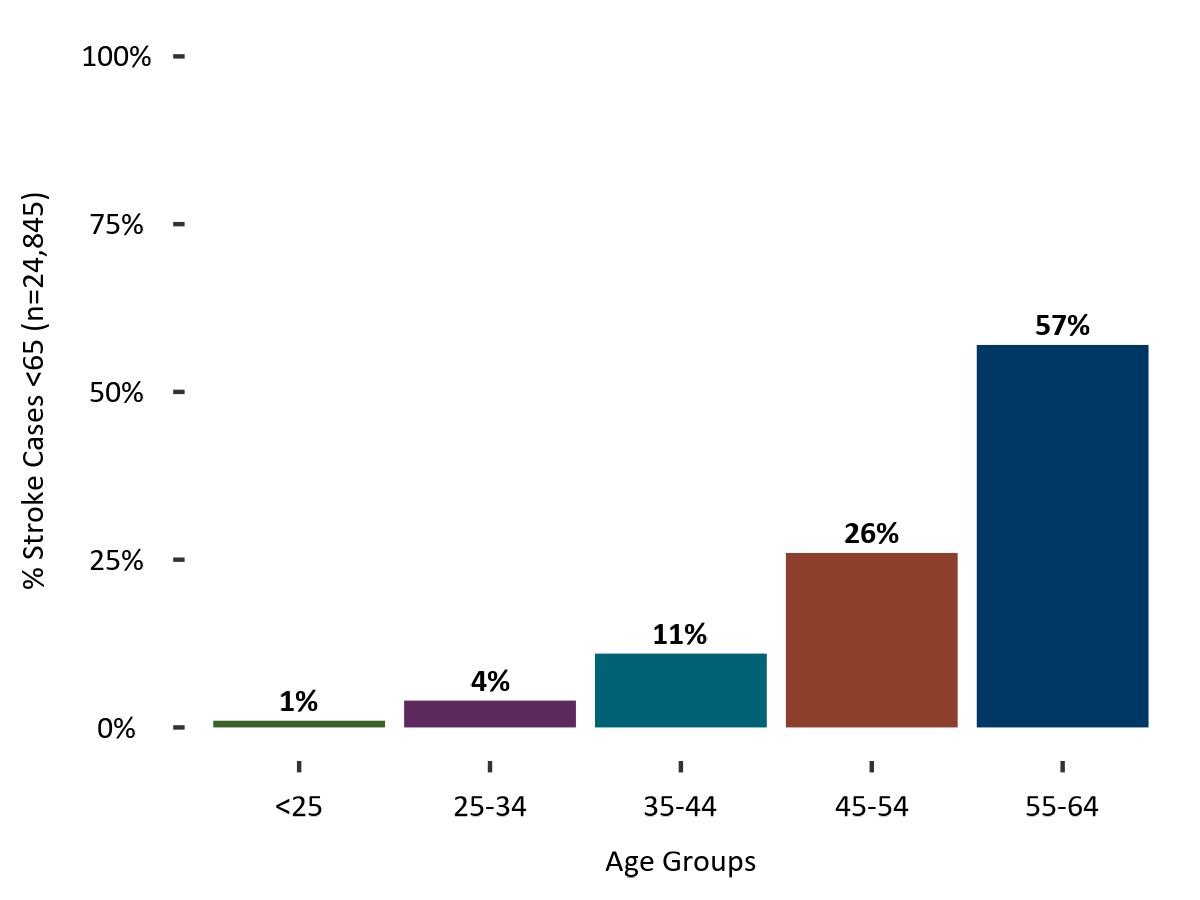
Men and women tend to experience stroke at different ages. The average age when female experience a stroke is around 74 years compared to around 70 years for male stroke patients.
More men are experiencing stroke during their working years than women. Thirty four percent of male stroke patients in the MSR are under age 65, compared to 25% of female stroke patients.
The average age of stroke patients also varies by race and ethnicity. Black, American Indian, Asian, and Hispanic stroke patients are all younger on average than white stroke patients. For instance, Black stroke patients in Minnesota are around 60 years old on average, almost 13 years younger than the average age of a white stroke patient. On average, Asian stroke patients are 64, Hispanic/Latino stroke patients are 62, American Indian stroke patients are 62, while white stroke patients are 73.
Chart 2. Average age of stroke patients in Minnesota by race/ethnicity, 2018-2024:
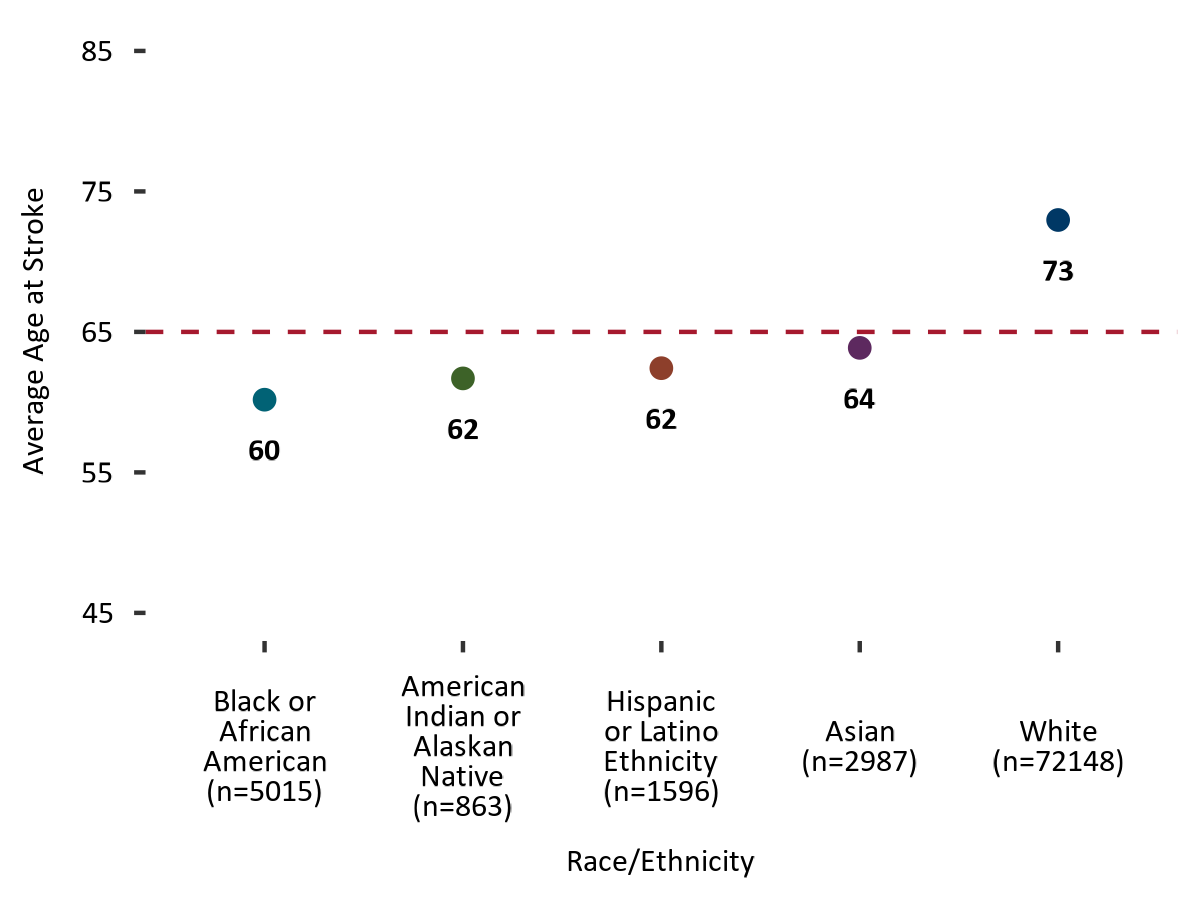
Getting to the hospital—as quickly as possible—is critical.
Because Angie was taken by ambulance to Sanford Thief River Falls Medical Center, a Minnesota Department of Health designated stroke ready hospital, the emergency medical team knew to activate a precise step-by-step process that helped save Angie’s life.
It is not only how quickly a stroke patient gets to the hospital that is important, the method of transportation also matters. When stroke patients arrive to the hospital in an ambulance, the hospital is often already notified of a suspected stroke and can move more quickly to activate stroke protocols.
Chart 3. Hospital arrival mode in Minnesota by age group, 2018-2024:
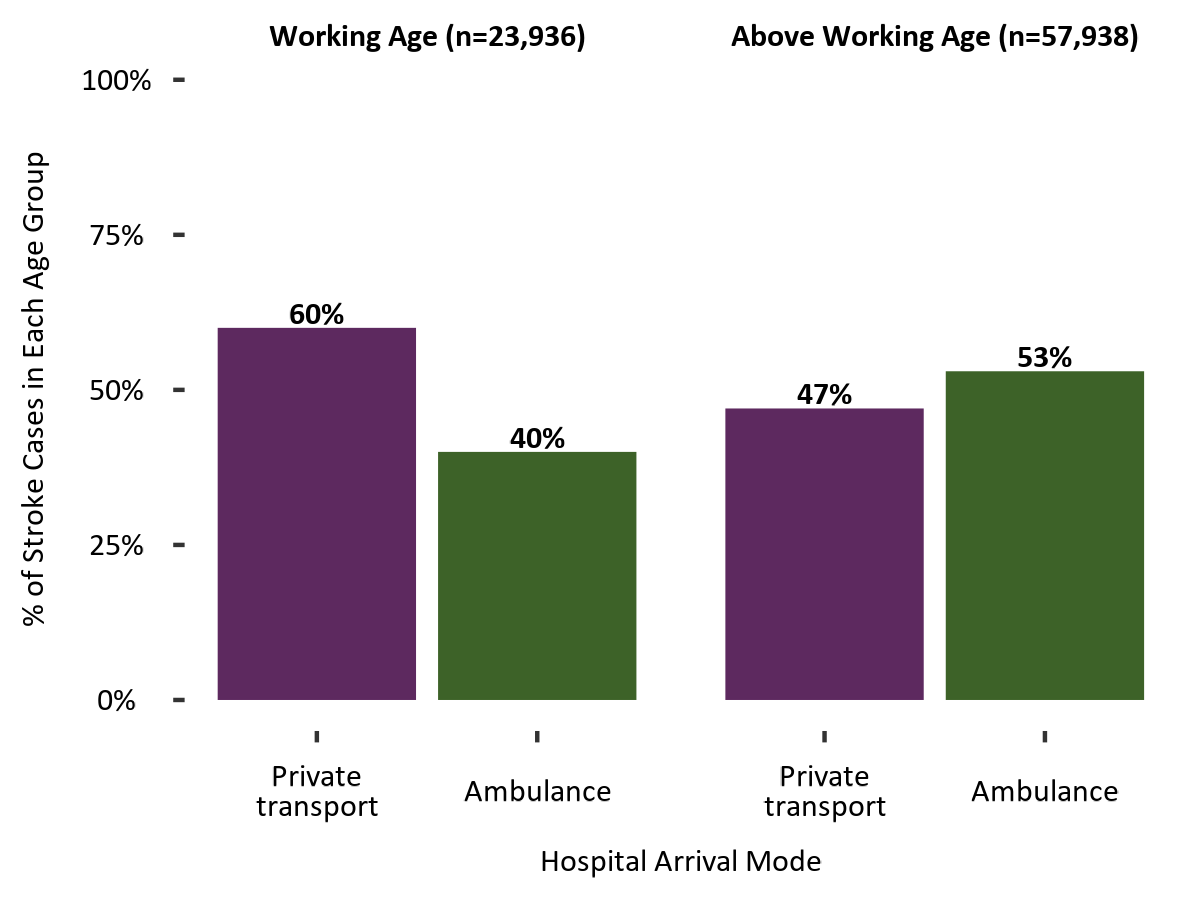
Working-age adults are less likely to arrive to the hospital via ambulance. 40 % of working-age adults in the MSR arrived via ambulance, compared to 53% of those above working age.
Faster treatment times improve stroke outcomes and recovery.
Arriving via ambulance leads to faster treatment times. Working age adults who arrive via ambulance usually receive treatment within about 40 minutes, compared to 51 minutes for those who arrive via private transportation.
Stroke risk factors
Several medical and lifestyle factors increase the risk of stroke, including:
- High blood pressure (hypertension)
- Diabetes
- Experiencing a stroke in the past
All three of these conditions are common among stroke patients ages 18-64.
Chart 4. Proportion of stroke patients under 65 years with stroke risk factors, 2018-2024:
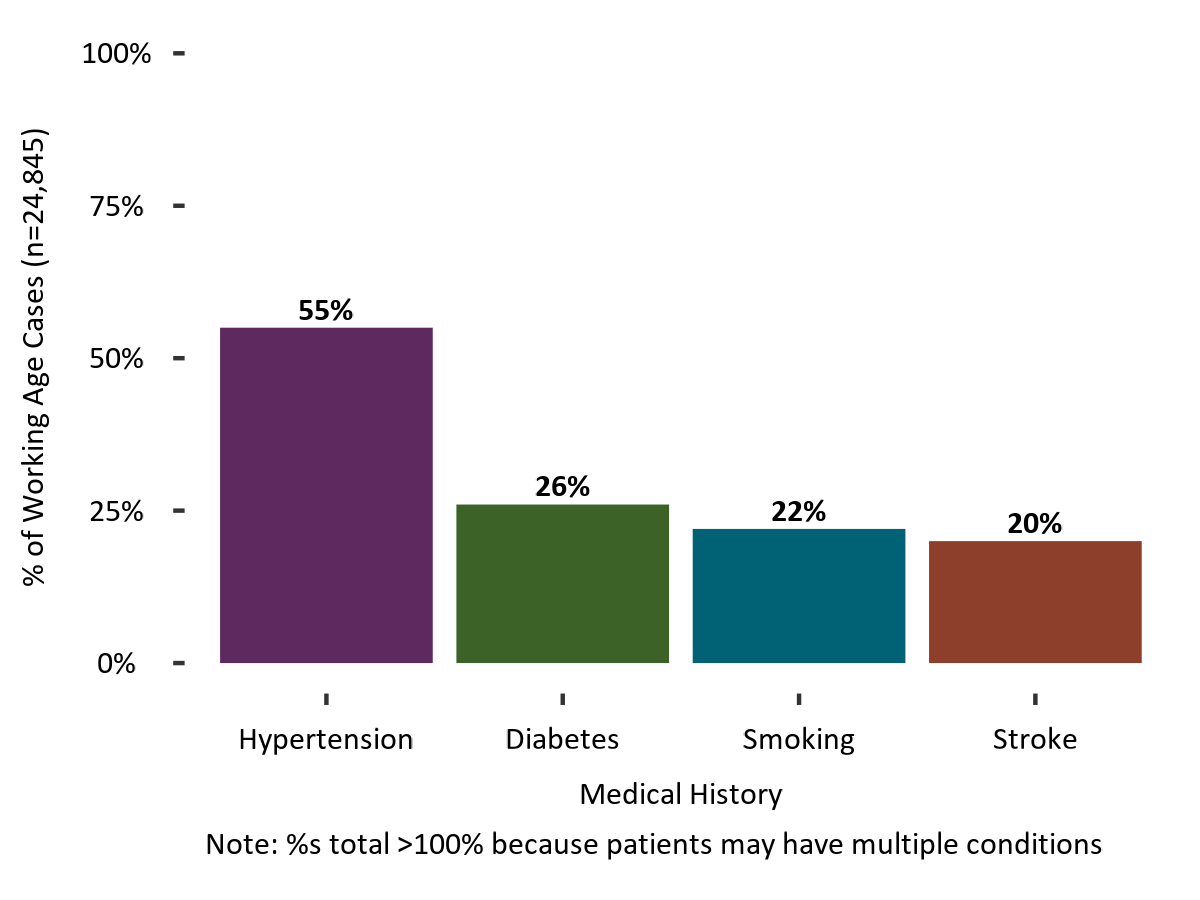
In Minnesota, 55% of stroke patients under age 65 had a documented history of hypertension, 26% had a history of diabetes, 22% had smoked cigarettes in the past year, and 20% had a history of previous stroke.
While Angie did not have any of these risk factors, she found out during her stroke treatment and care that she had a patent foramen ovule, a small opening in her heart that was causing her lifelong migraines and contributed to her stroke. Angie’s medial team determined that closing the hole in her heart would decrease her risk of having another stroke. She had the procedure and has recovered fully.
Outcomes of stroke
Stroke can lead to long-term disability. These disabilities may be physical or cognitive.
- 40% of strokes among working-age adults result in moderate to severe disability immediately after they occur.
- 27% of working-age adults have a reduced ability to walk independently when they are discharged from the hospital.
- 26% of working-age stroke patients are discharged to a skilled nursing facility, in-patient rehabilitation setting, or a long-term care facility after their hospital stay. Stroke survivors with disabilities may also be discharged home, where they may need in-home rehabilitation or assistance with activities of daily living.
Chart 5. Discharge destination for stroke patients under age 65:
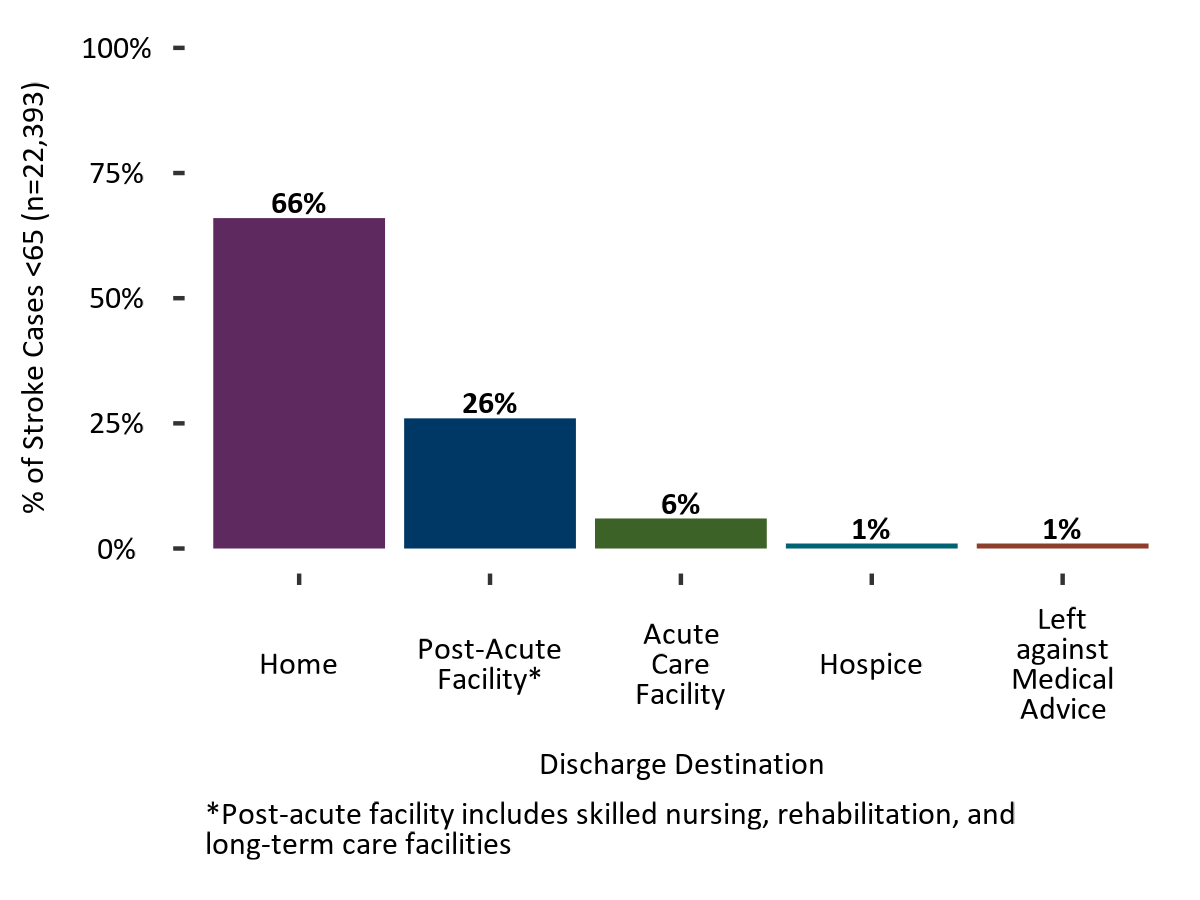
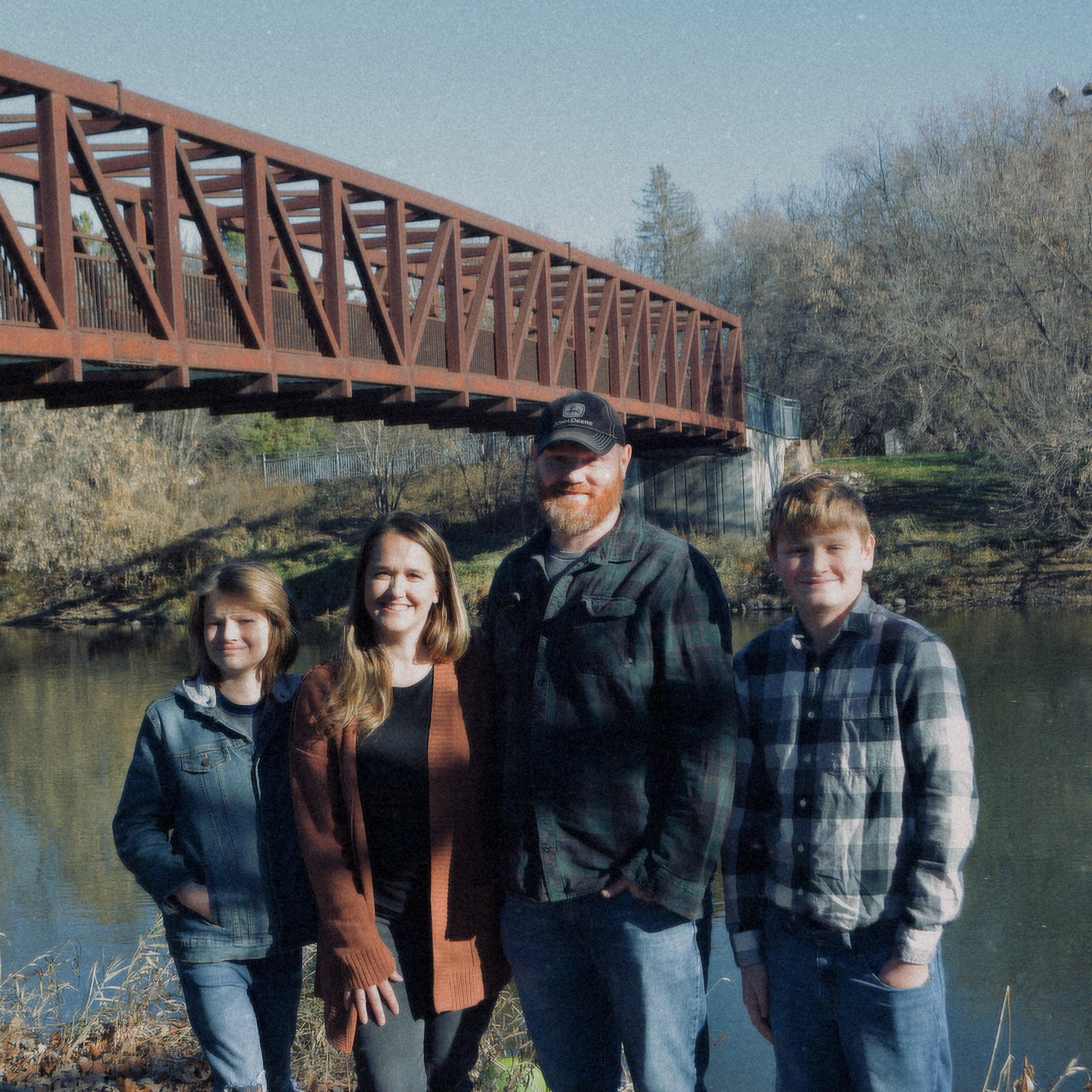
Luckily Angie fully recovered from her stroke and was back to her normal activities within a few months. While she does not have any long-term disabilities, she does have ongoing anxiety that she might have another stroke.
Support is available
Resources are available to help stroke survivors of any age adjust to life after stroke. The Minnesota Brain Injury Alliance offers a free program that connects stroke survivors to services and supports to address a variety of needs that may arise after stroke.
Know the signs and symptoms
“It can be easy to ignore symptoms, but if you notice anything out of the ordinary, pay attention.”
Help keep yourself and your loved ones safe by recognizing the warning signs of stroke and calling 911. An easy way to remember how to recognize a stroke is “BE FAST:”
B – Balance loss. Does the person have sudden loss of balance or coordination?
E – Eyesight changes. Is eyesight suddenly blurred or double? Is there a sudden loss of vision?
F – Face drooping. Does one side of the face droop or is it numb? Ask the person to smile.
A – Arm weakness. Is one arm weak or numb? Ask the person to raise both arms. Does one arm drift downward?
S – Speech difficulty. Is speech slurred, are they unable to speak, or are they are they hard to understand?
T – Terrible headache. Time to call 911. If the person shows ANY of these symptoms, even if the symptoms go away, call 911 and get them to a hospital immediately.
“I want everyone to know stroke symptoms,” Angie said. “If I had just gone to sleep in my room, it would have been a completely different story. It can be easy to ignore symptoms, but if you notice anything out of the ordinary, pay attention.”
For more information, read our Data Story: Stroke in Working Age Minnesotans (PDF)
Minnesota Stroke Designated Hospitals
The Sanford Thief River Falls Medical Center where Angie was treated is a designated Acute Stroke Ready Hospital. Since 2014, the Stroke Program at MDH has been designating stroke hospitals and improving stroke care in hospitals by providing ongoing education as well as strategies to identify stroke process improvements, protocols and more. MDH works with hospitals and partners to ensure designated hospitals are equipped and prepared to treat stroke quickly.
Learn more: Minnesota Stroke System






